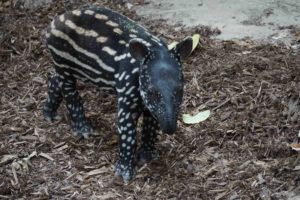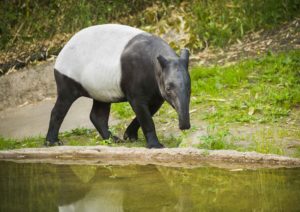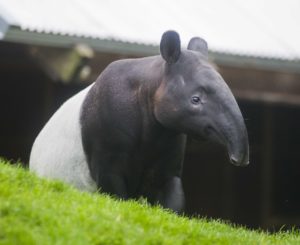Endangered Malayan tapirs Yuna and Baku strolled around one of the Asian Forest Sanctuary exhibits on Wednesday afternoon, grazing on grasses – and keeping a secret.
Not even the birds perched in the nearby trees would tweet the news.
But we can let you in on this uber-exciting development today.

Hooray! Hooray! A baby tapir is on the way!
Well, technically – officially – it will be a calf. And they’re pretty rare. Only one to two are born in North American zoos each year.
And when it arrives? Well, think of a brown watermelon with spots. That’s what it will look like – utterly adorable.
Zoo General Curator Dr. Karen Goodrowe Beck made the announcement today: Yuna is about four months pregnant.
A Rare Arrival

The calf is due next summer to mother Yuna and father Baku, both 4 ½-year-old tapirs. Baku came to Point Defiance Zoo & Aquarium three years ago from Denver Zoo, where he was born. Yuna arrived from Africam Safari in Mexico in 2016.
The pair is part of the Species Survival Plan®, a managed breeding program for Malayan tapirs in North America. Their calf will be the first tapir ever born at Point Defiance Zoo & Aquarium.
“This pregnancy is wonderful news for Point Defiance Zoo & Aquarium,” said Metro Parks Tacoma Board of Commissioners President Andrea Smith. “It highlights the zoo’s continuing commitment to the conservation of some of the world’s most rare and endangered species. And it represents both hard work and a high-level of animal care on the part of zoo staff members.”
There are just 46 Malayan tapirs in the North American Species Survival Plan®, said Goodrowe, who holds a Ph.D. in reproductive physiology.
“We’re excited by this pregnancy and the opportunity to add to this small population,” said Telena Welsh, senior staff biologist in the zoo’s Asian Forest Sanctuary. Zoo veterinary and curatorial staff confirmed the pregnancy via ultrasound; Yuna has been trained to voluntarily lie still for these exams.
Getting to Know You

Though Baku has been at Point Defiance Zoo for three years and Yuna for two, keepers needed to wait for them to grow and sexually mature before introducing them to one another, Welsh said.
They have lived next to each other in the Asian Forest Sanctuary bedroom areas since the end of 2016 but were not introduced to one another for breeding until spring of this year.
Malayan tapirs generally bear only one calf at a time, although twins can rarely occur. The gestation period is about 13-14 months long, and calves weigh around 22 pounds at birth.
For their first several months of life, tapir calves are a distinct blackish brown color with white stripes and spots or splotches on their bodies. This configuration helps the fragile newborns stay better camouflaged among the foliage. Tapir calves nurse until they are about 6 months and typically stay with their mothers until they’re 12-to-18 months old.
Camouflage and a keen nose
Adult tapirs have black heads, long black snouts and are black for about the first third of their bodies before the dark color gives way to a gray back and abdomen, with black hind quarters, sitting atop four sturdy, hooved black legs.
This odd color combination helps the nocturnal herbivores blend into moonlit rainforests and shields them from predators. They have great hearing and a wonderful sense of smell, thanks to that large, elongated nose that helps them both sniff out and snare their food. Their eyesight, however, is poor.
Adult female tapirs can grow up to about 1,000 pounds; males, the smaller of the species, can top 800 pounds. At their last weigh-in, Yuna weighed 743 pounds and Baku tipped the scales at 672; they’re both still growing.
Endangered in the wild
Malayan tapirs are native to the Malay Peninsula, the island of Sumatra, southern Myanmar and southern Thailand. The species is endangered, its numbers decreasing in the wild as their natural habitat is lost to human development, according to the International Union for Conservation of Nature.
Point Defiance Zoo & Aquarium has cared for Malayan tapirs for many years. The species was new to the zoo when the Asian Forest Sanctuary opened in 2004. The zoo has supported the species’ conservation in the wild through grants from The Zoo Society’s Dr. Holly Reed Wildlife Conservation fund.
Yuna and Baku are guest favorites, especially when they spend time interacting with our primates on exhibit,” Welsh said. We hope people will join us in celebrating this conservation milestone and wish Yuna well on her first adventure into motherhood.”
-Kris Sherman, PDZA